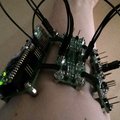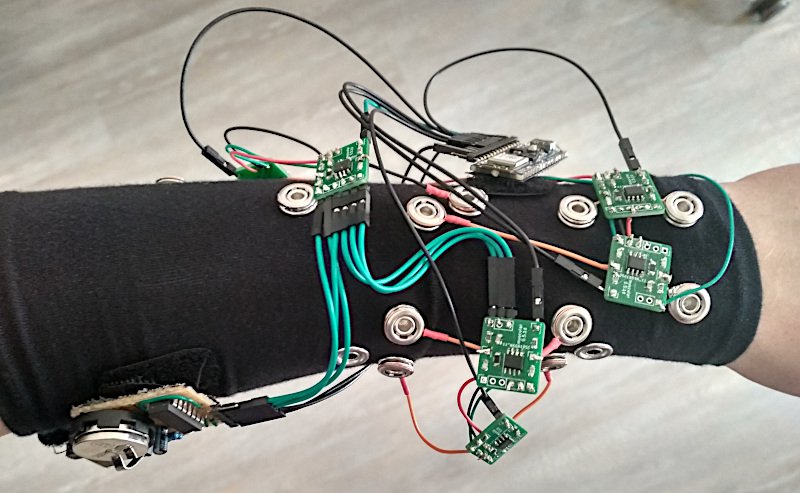
 with ultrasound you probably wouldn't be measuring the nerve activity you'd be measuring the actual contraction of the muscle, but it might fill in the gaps..
with ultrasound you probably wouldn't be measuring the nerve activity you'd be measuring the actual contraction of the muscle, but it might fill in the gaps..
 Didn't know you could use ultrasound for that, that's fascinating
Didn't know you could use ultrasound for that, that's fascinating
 @anfractuosity Focused ultrasound was first used for surgery and cancers, I think. Getting to the level of sensitivity and care to sense and stimulate individual nerves took time and a lot of data. Most of the raw data went into human neural nets, so none of it got shared. If your group shares the raw data, there are groups world wide who can work on algorithms and clearly defined tasks and tests.
@anfractuosity Focused ultrasound was first used for surgery and cancers, I think. Getting to the level of sensitivity and care to sense and stimulate individual nerves took time and a lot of data. Most of the raw data went into human neural nets, so none of it got shared. If your group shares the raw data, there are groups world wide who can work on algorithms and clearly defined tasks and tests.
 It's literally "The machine that goes 'PING!'"
It's literally "The machine that goes 'PING!'"
 @RichardCollins intriguing, not sure i knew it was used for cancers. I recall touching an ultrasonic fogger thing, and it seemed to hurt a bit
@RichardCollins intriguing, not sure i knew it was used for cancers. I recall touching an ultrasonic fogger thing, and it seemed to hurt a bit
 what kind of pain? heat? :)
what kind of pain? heat? :)
![]() with array of transducers you can steer the beam/focal point. lots of videos on youtube.
with array of transducers you can steer the beam/focal point. lots of videos on youtube.
 yeah hard to explain heh, i guess it felt like heat
yeah hard to explain heh, i guess it felt like heat
 that's interesting you're using gnuradio companion for some stuff :)
that's interesting you're using gnuradio companion for some stuff :)
 The concept of using the existing muscles is powerful. Exoskeletons and robotic assistance is costly and clumsy. Take the "intention" signals and send them to a body controller that knows the 3D structure and properties, then determines the muscles needed and their response signals - is possible. Big data, external computer needed for prototypes, but wireless sensors and stimulation. Look at TENS stimulators, they are high voltages cheap circuits, but timing and strength can stimulate the right nerver. About 650 muscles in the body.
The concept of using the existing muscles is powerful. Exoskeletons and robotic assistance is costly and clumsy. Take the "intention" signals and send them to a body controller that knows the 3D structure and properties, then determines the muscles needed and their response signals - is possible. Big data, external computer needed for prototypes, but wireless sensors and stimulation. Look at TENS stimulators, they are high voltages cheap circuits, but timing and strength can stimulate the right nerver. About 650 muscles in the body.
![]() that's good for assistive tech/medical tech. but the force doesn't scale for exoskeleton use. different domain, though, but could also work for physical telepresence.
that's good for assistive tech/medical tech. but the force doesn't scale for exoskeleton use. different domain, though, but could also work for physical telepresence.
 @anfractuosity Yes, I found that this is the best data plotter for my purposes, although it feels like it hasn't exactly been designed for my use case :D
@anfractuosity Yes, I found that this is the best data plotter for my purposes, although it feels like it hasn't exactly been designed for my use case :D
 The software defined radio groups are expanding and improving every day. They are into 10s of gigasamples per second at 12 bits. If you have the money you can get most anything you want. But the 10 Msps (megasamples per second) 10 bit low cost devices give you FFTs to work with in a community where some of the hard parts are done for you. Then focus on algorithms and applications.
The software defined radio groups are expanding and improving every day. They are into 10s of gigasamples per second at 12 bits. If you have the money you can get most anything you want. But the 10 Msps (megasamples per second) 10 bit low cost devices give you FFTs to work with in a community where some of the hard parts are done for you. Then focus on algorithms and applications.
![]() biosignals should work with way lower samplerates.
biosignals should work with way lower samplerates.
 the highest useful sampling rate for surface EMG is around 4kHz, though 500Hz gives you most of the signal already
the highest useful sampling rate for surface EMG is around 4kHz, though 500Hz gives you most of the signal already
 You should be able to use an SDR with a tiny bit of electrical fiddling to get high sampling rate FFTs. The radio signals are microvolts. The USB oscilloscope groups are also going faster - using the same technologies. They just don't have FFT and neural net software plugged in. They can handle millivolts signals with differential amplfiers more and more built into the oscilloscope programmable amplifier front ends.
You should be able to use an SDR with a tiny bit of electrical fiddling to get high sampling rate FFTs. The radio signals are microvolts. The USB oscilloscope groups are also going faster - using the same technologies. They just don't have FFT and neural net software plugged in. They can handle millivolts signals with differential amplfiers more and more built into the oscilloscope programmable amplifier front ends.
 does anybody know good dry electrodes that one could use for EMG? I'm still using very suboptimal ones
does anybody know good dry electrodes that one could use for EMG? I'm still using very suboptimal ones
 using an SDR for processing biosignals sure sounds interesting, haven't thought of that
using an SDR for processing biosignals sure sounds interesting, haven't thought of that
 I'd imagine the dry EEG electrodes (either gold or Ag/AgCl) would work, although I've never tried
I'd imagine the dry EEG electrodes (either gold or Ag/AgCl) would work, although I've never tried
 will try them out
will try them out
 thank you @Preston
thank you @Preston
 if you have any more questions after this session, you can come to PsyLink's Matrix chatroom any time: https://matrix.to/#/#psylink:matrix.org
if you have any more questions after this session, you can come to PsyLink's Matrix chatroom any time: https://matrix.to/#/#psylink:matrix.org
 @hut we have some limited success with conductive fabric - but can't say I'm satisfied with it, looking for better options
@hut we have some limited success with conductive fabric - but can't say I'm satisfied with it, looking for better options
 @hut You know I'm using brass or silver-plated corkboard pins or copper shimmies from laptop CPUs since theyre both cheap, but I'm yet to have a good comparison between them (https://github.com/PerlinWarp/pyomyo/wiki/The-basics-of-EMG-design ).
@hut You know I'm using brass or silver-plated corkboard pins or copper shimmies from laptop CPUs since theyre both cheap, but I'm yet to have a good comparison between them (https://github.com/PerlinWarp/pyomyo/wiki/The-basics-of-EMG-design ).
Anyone know if these are horrible ideas? ahah
 doesnt copper / silver tarnish though?
doesnt copper / silver tarnish though?


 older prototypes used snap buttons that are typically found in jackets or other clothing
older prototypes used snap buttons that are typically found in jackets or other clothing
 Electron paramagnetic resonance spectroscopic microscopy, and NMR imaging spectroscopic microscopy and other groups are trying to measure (non invasive) nerve activity. The microscopic is mostly cubic millimeter voxels, but people go larger. Imaging ultrasound can modulate electrical signals so groups are combining EEG MEG (magneto) and other non contact electromagnetic measurements with ultrasound. All for tracking nerve activity.
Electron paramagnetic resonance spectroscopic microscopy, and NMR imaging spectroscopic microscopy and other groups are trying to measure (non invasive) nerve activity. The microscopic is mostly cubic millimeter voxels, but people go larger. Imaging ultrasound can modulate electrical signals so groups are combining EEG MEG (magneto) and other non contact electromagnetic measurements with ultrasound. All for tracking nerve activity.
 And just like that, our time is up! Really good discussion, great way to kick off 2022! I want to thank hut for his time today, and all of you for the great questions and insights. Feel free to keep the discussion going here, you're welcome to stay as long as you like. Thanks all!
And just like that, our time is up! Really good discussion, great way to kick off 2022! I want to thank hut for his time today, and all of you for the great questions and insights. Feel free to keep the discussion going here, you're welcome to stay as long as you like. Thanks all!
 Thank you Dan for inviting me!
Thank you Dan for inviting me!
 You're welcome! And everyone make sure you come back for next week's chat:
You're welcome! And everyone make sure you come back for next week's chat:
 Thanks @hut
Thanks @hut

https://hackaday.io/event/183427-compliant-mechanisms-hack-chat
 that was really cool! look forward to reading more about your project :)
that was really cool! look forward to reading more about your project :)
 the link isn't valid
the link isn't valid
 Thanks everyone :)
Thanks everyone :)
 The stakes are high. Many people become paralyzed from accidents and diseases, but also drugs and stroke. So tens of millions need devices to measure "intention" by nerve activity or small muscle movements - and translate that to muscles stimulations or to machine controls. The intentional use by anyone means driving vehicles and operating complex equipment.
The stakes are high. Many people become paralyzed from accidents and diseases, but also drugs and stroke. So tens of millions need devices to measure "intention" by nerve activity or small muscle movements - and translate that to muscles stimulations or to machine controls. The intentional use by anyone means driving vehicles and operating complex equipment.
 sorry, now it's good
sorry, now it's good
 @Nicolas Tremblay - Sorry about that, it was still private. I changed it to public
@Nicolas Tremblay - Sorry about that, it was still private. I changed it to public

https://hackaday.io/event/183427-compliant-mechanisms-hack-chat
 Thanks @hut !
Thanks @hut !
 @anfractuosity For more news, you can subscribe to the RSS feed of the development blog [https://psylink.me/index.xml] or follow PsyLink on Mastodon: https://fosstodon.org/@psylink
@anfractuosity For more news, you can subscribe to the RSS feed of the development blog [https://psylink.me/index.xml] or follow PsyLink on Mastodon: https://fosstodon.org/@psylink
 oh cheers, i like rss too
oh cheers, i like rss too
 thank you @hut and everyone else for a 'stimulating' conversation.
thank you @hut and everyone else for a 'stimulating' conversation.
 my pleasure, thank you all too!
my pleasure, thank you all too!
 Thanks everyone, especially @hut and @Dan Maloney !
Thanks everyone, especially @hut and @Dan Maloney !
 Dan Maloney
Dan Maloney
Discussions
Become a Hackaday.io Member
Create an account to leave a comment. Already have an account? Log In.